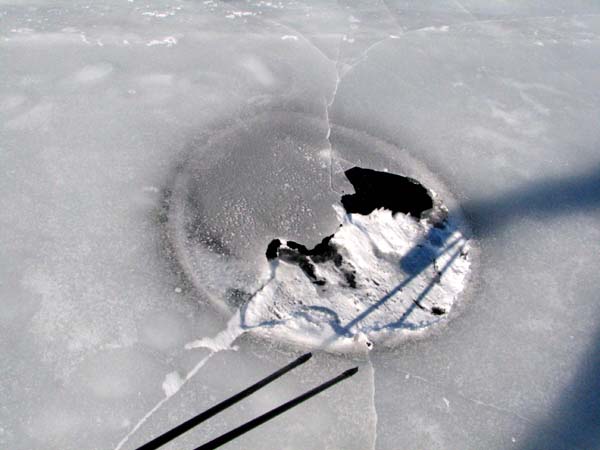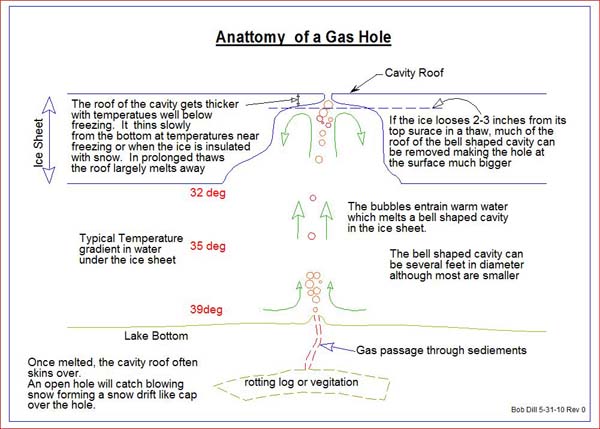Gas Holes
 18" gas hole with partial thin cover. Sucker Brook delta, Lake Dunmore VTGas holes are created by a persistent source of gas from rotting vegetation under the lake bottom. The rising bubbles drag up water from a few feet below the surface. This water is usually a couple or three degrees above freezing. The steady flow of above freezing water melts out a bell shaped cavity in the ice. In cold weather there is often just a small hole in the roof of the cavity to let the gas out. If there is a thaw that takes a few inches off the top of the ice the top of the bell can be exposed (or be covered with thin ice). The bells can be several feet in diameter which often form open holes after a thaw. If the gas flow is strong enough they will stay open or have a thin skin in cold weather.
18" gas hole with partial thin cover. Sucker Brook delta, Lake Dunmore VTGas holes are created by a persistent source of gas from rotting vegetation under the lake bottom. The rising bubbles drag up water from a few feet below the surface. This water is usually a couple or three degrees above freezing. The steady flow of above freezing water melts out a bell shaped cavity in the ice. In cold weather there is often just a small hole in the roof of the cavity to let the gas out. If there is a thaw that takes a few inches off the top of the ice the top of the bell can be exposed (or be covered with thin ice). The bells can be several feet in diameter which often form open holes after a thaw. If the gas flow is strong enough they will stay open or have a thin skin in cold weather.

Gas holes are common in certain areas and unknown in many others. Most are associated with inlet stream deltas. Shallower water with heavy aquitic vegitation also appear to be potential problem areas. Areas of a lake that have them tend to appear in the same area year after year. We have found a few solitary gas holes well away from shore and any stream. Solitary holes are uncommon but insidious. So far we have not found any in water over 50 feet deep.
3' by 7' deroofed gashole on 2/16/2013. Water depth: between 6' and 12'. This may be an isolated gas hole. Location: N44 deg 49' 3.456", W73 deg 17' 11.028". Note the use of locally available materials to mark the hazard.
Gas holes tend to be a problem in the early part of the season and after any significant thaw. By mid-season the cold weather often overpowers the ability of the gas to keep the hole open. If the is snow on the ice (as is often the case) the insulation the snow provides lets the ice roof of melt leaving a snow cap. Don't count on it to hold up a person let alone a pickup.
Characteristics of Gas Holes
- They have a stream of gas bubbles in their center. The bubble stream is often intermittent. Sometimes you have to wait a minute or two for a flock of bubbles to come up.
- They are typically round with a dimension of 1 to 4 feet although they often join together to form larger, irregular holes.
- There is an irregular area of thinner ice around the hole (the cavity roof)
- When the cavity roof covers the hole, they can be hard to see if there are not white bubbles frozen into the ice of the roof.
- They are almost always in the same area or even the same exact spot from year to year. When you are new to a lake, ask the locals about these and other hazards.
- If the ice is clear it will often have large white gas bubbles in areas that might have gas holes.
- Testing with a test pole of some sort is the best way to tell if an area is OK for body weight.
- They can be hard to see when moving over the ice quickly . If there is snow on the ice they will be obscured. A thin layer of fluffy snow over a field of gas holes can leave the ice skatable but with many invisible hazards. Vehicles and gas hole fields are a bad combination.
- They are more of a problem in the early and late season than in the cold part of the winter.
- They typically get a snow drift like cap if there is blowing snow. It can look like a normal drift or, sometimes, it will have a more granular appearance. This cap may be strong enough to hold a person or an iceboat runner or maybe not.
- If you find one gas hole expect to find more nearby.
